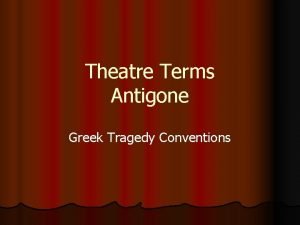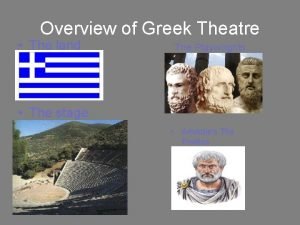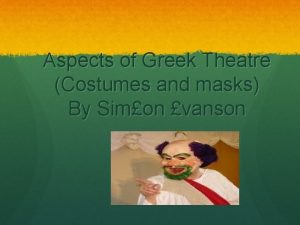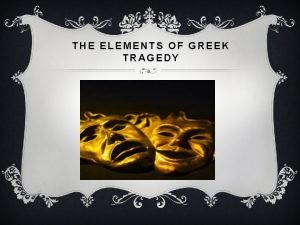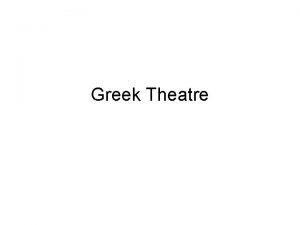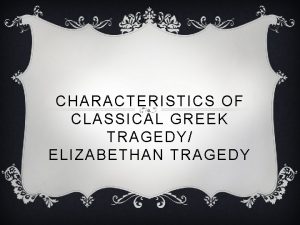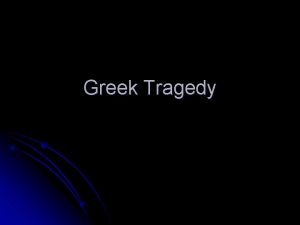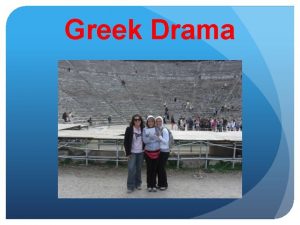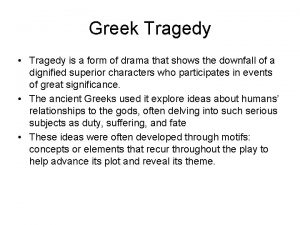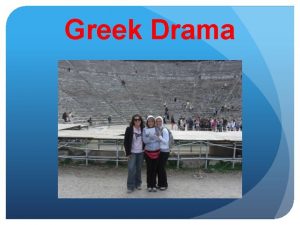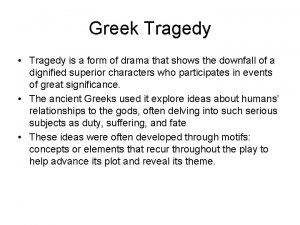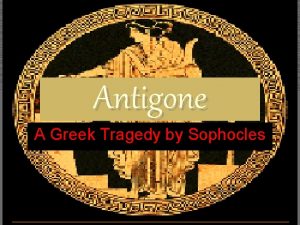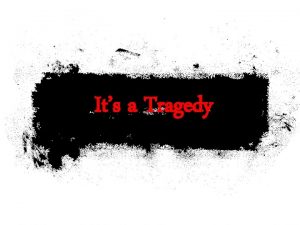Greek Tragedy Unit Notes Tragedy A play in















- Slides: 15

Greek Tragedy Unit Notes

Tragedy • A play in which a main character, or tragic hero, suffers a downfall • Came into being during the 5 th century • A blending of poetry, drama, music, and dance • First performed in honor of Dionysos, the god of wine and fertility

Tragedy cont’d • Sources of plots were myths and everyday life • Function was to arouse pity and fear in the audience to purge or cleanse them of these unsettling emotions

Thespis – father of drama • First to use an actor in his productions • Performed first tragedy at the festival of Dionysos in 534 B. C.

Three Important Writers of Greek Tragic Drama • Aeschylus – Established true dialogue by adding a second actor

Important Writers cont’d • Sophocles – Introduced a third actor – Introduced painted sets – Expanded the size of the chorus to 15 – Changed the kinds of music used by chorus

Important Writers cont’d • Euripides – Used the chorus as commentator and an ornament to main dialogue

Purposes of chorus • Create a psychological and emotional background through its odes • Introduce and question new characters • Point out the significance of events • Establish facts and affirm the outlook of society • Cover the passage of time between events • Separate episodes

Main divisions of a typical tragedy • Prologue – opening scene to establish background of story • Parados – entrance of the chorus (usually chanting a lyric) • Episode – counterpart of the modern act or scene

Main divisions cont’d • Stasimon – choral ode; comes at the end of each episode • Exodus – final action after last stasimon; ended by ceremonial exit of all players

Conventions of Greek Theater • • Limited number of actors All male actors Broad stage movements Elongated masks to denote character played, amplify sound, allow same character to play several parts

Conventions cont’d • Boots with built-up soles • Elaborate and colorful costumes • Minimal scenery because there was no curtain • Altar to Dionysos at center stage ensuring some reference to gods • Prohibition against violence on stage

Elements of Tragedy • Reversal of situation – a change by which the action veers around to its opposite • Scene of recognition – a change from ignorance to knowledge • Scene of suffering – a scene of destructive or painful action • A tragic hero initiates his own downfall

Traits of a Tragic Hero In tragedy, the central character: • Passes from happiness to misery • Must not be perfectly virtuous and just • Must initiate his own downfall by a flaw of character (tragic flaw) or by an error in judgment

Unities of Greek Theater • Action – one basic story • Time – within 24 hours • Place – few scene changes
 History of drama
History of drama Shakespeare comedy vs tragedy
Shakespeare comedy vs tragedy Features of shakespearean drama
Features of shakespearean drama Greek tragedy notes
Greek tragedy notes I've got a friend we like to play we play together
I've got a friend we like to play we play together Play random play basketball
Play random play basketball Play by play
Play by play Play within the play hamlet
Play within the play hamlet Anagnorisis greek theatre definition
Anagnorisis greek theatre definition Antigone overview
Antigone overview Ekkyklêma
Ekkyklêma Introduction to greek tragedy
Introduction to greek tragedy Greek costumes in theatre
Greek costumes in theatre Elements of greek tragedy
Elements of greek tragedy Structure of tragedy
Structure of tragedy Sophocles
Sophocles








